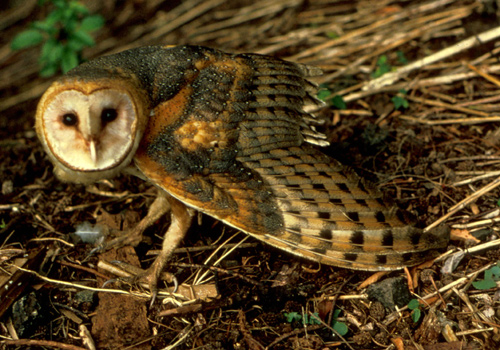Barn owls are exceptionally beautiful. Their faces are a heart-shaped, white-feathered disk. Their heads are round and their bodies are light brown to golden brown with grey markings. The adults can weigh between 1 and 1 1/2 pounds and their wingspans are about 4 feet.
Owls fly very quietly. They have specially-designed, sound-absorbing feathers that allow them to accomplish silent flight. Their feathers tend to absorb high-frequency sound, and in addition the leading edges of their wing feathers have a fringe called flutings that both aid in stable flight and muffle the sound of air moving over the wing. Feathers trailing from the back of their wings mitigate sound waves produced by air flowing over the wing and off of the back.
The barn owl's most familiar call is a scream. Click the link under the photo for an example. They can also make clicks, squeaks and quieter shrieks.
Barn owls are permanent residents in the eastern, western and southern regions of the US. They will range farther north during the summer.
Barn owls are Endangered in Connecticut. They are most common along the coast and in river valleys in this state. Their Connecticut population is declining from habitat loss as reforestation increases.
Barn owls live along open areas like meadows, fields and marshland. They used to use cliffs for roosting, but adapted to human encroachment by often using structures such as barns. Hence their name. They will also roost in tall trees. Owls are nocturnal.
Owls have excellent vision and hearing which they use to find prey. Barn owls eat small mammals such as mice, voles, shrews, bats and skunks. They will also eat birds frogs and sometimes large insects. They tend to dive down silently on their prey and capture it with their strong, sharp talons. Barn owls swallow their prey whole. They later regurgitate undigestible parts like bones and hair in a compact lump called an owl pellet.
In Connecticut barn owls breed and nest in February and March. Owls tend to mate for life, and find each other each mating season. Barn owls nest in tree cavities, barns, and sometimes chimneys. They usually lay 5 to 11 eggs. The eggs take about a month to hatch and both parents care for the young for about 2 months. The lifespan of barn owls is about 3 to 4 years in the wild.
